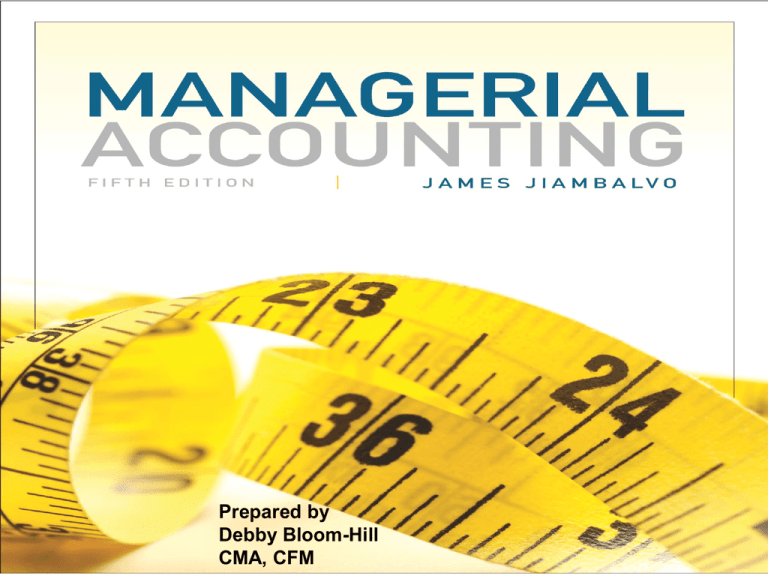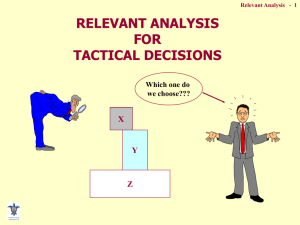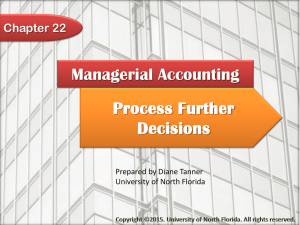
Prepared by
Debby Bloom-Hill
CMA, CFM
CHAPTER 7
Use of Cost Information in
Management Decision
Making
Slide 7-2
Incremental Analysis
Incremental analysis
All decisions involve a choice among
alternative courses of action
The solution to business problems
involves incremental analysis
Incremental analysis is the analysis of
the incremental revenue and
incremental costs incurred when one
alternative is chosen over another
Slide 7-3
Learning objective 1: Explain the role of incremental analysis (analysis of
incremental costs and revenues) in management decisions
Incremental Analysis
Incremental Revenue
Additional revenue received by
selecting one alternative over another
Incremental Cost
Additional cost incurred by selecting
one alternative over another
Incremental Profit
Difference between incremental
revenue and incremental cost
Slide 7-4
Learning objective 1: Explain the role of incremental analysis (analysis of
incremental costs and revenues) in management decisions
Incremental Analysis
An alternative that yields an
incremental profit should be selected
Incremental costs are referred to as
relevant costs
Also called differential costs because
they are the costs that differ between
decision alternatives
Slide 7-5
Learning objective 1: Explain the role of incremental analysis (analysis of
incremental costs and revenues) in management decisions
Incremental Analysis Example
Jensen’s Rapid Copy is considering
extending its hours
Alternative 1 is the status quo
Alternative 2 involved the company
extending their hours from 8 pm to
midnight
The next slide shows the incremental
costs and revenues associated with
choosing one alternative over another
Slide 7-6
Learning objective 1: Explain the role of incremental analysis (analysis of
incremental costs and revenues) in management decisions
Incremental Analysis Example
Slide 7-7
Learning objective 1: Explain the role of incremental analysis (analysis of
incremental costs and revenues) in management decisions
Incremental Analysis
Incremental Analysis can be
extended to more than two
alternatives
Calculate profit for each alternative
The alternative with the highest
profit is the best alternative
Difference between its profit and the
profit of any other alternative is its
incremental profit
Slide 7-8
Learning objective 1: Explain the role of incremental analysis (analysis of
incremental costs and revenues) in management decisions
“What Does This Product Cost?”
Answer: Why do you want to know?
No single cost number is relevant for
all decisions
Must find incremental information
that is applicable to the decision
Some costs will change due to the
decision, some will not
Only costs that change are relevant
Slide 7-9
Learning objective 1: Explain the role of incremental analysis (analysis of
incremental costs and revenues) in management decisions
Which of the following is likely to be an
incremental cost associated with increasing
planned production run of 1,000 units to 1,010
units?
a. Set-up costs
b. Depreciation of equipment
c. Inspection costs
d. Material costs
Answer: d
Material costs are variable costs and usually
incremental
Slide 7-10
Learning objective 1: Explain the role of incremental analysis (analysis of
incremental costs and revenues) in management decisions
Analysis of Decisions Faced
by Managers
Three decisions that managers
frequently face:
1. The decision to engage in
additional processing of a product
2. The decision to make or buy a
product
3. The decision to drop a product line
Slide 7-11
Learning objective 1: Explain the role of incremental analysis (analysis of
incremental costs and revenues) in management decisions
Additional Processing Decision
Manufacturers must occasionally
decide whether to:
Sell a product in a partially completed
stage, or
Incur additional processing costs
required to complete the product
Costs incurred to date of decision on
partially complete product are not
relevant, i.e sunk costs.
Slide 7-12
Learning objective 1: Explain the role of incremental analysis (analysis of
incremental costs and revenues) in management decisions
Additional Processing Decision –
Bridge Computer Example
Summary of cost information
Slide 7-13
Learning objective 1: Explain the role of incremental analysis (analysis of
incremental costs and revenues) in management decisions
Additional Processing Decision –
Bridge Computer Example
Incremental analysis summary
Incremental revenues are $500
Incremental costs are $400
Would you spend $400 to generate an
additional $500?
Answer: Yes, incremental profit is
$100
Slide 7-14
Learning objective 1: Explain the role of incremental analysis (analysis of
incremental costs and revenues) in management decisions
Additional Processing Decision –
Bridge Computer Example
Incremental analysis summary
Revenue
Prior Production Costs
Additional Processing Costs
Gain (loss) per unit
Sell Partially Sell Fully
Complete
Complete
Incremental
$500
$1,000
$500 a
(800)
(800)
0
0
(400)
(400) b
($300)
($200)
$100 c
a. Incremental revenue associated with alternative 2
b. Incremental cost associated with alternative 2
c. Incremental profit associated with alternative 2
Slide 7-15
Learning objective 1: Explain the role of incremental analysis (analysis of
incremental costs and revenues) in management decisions
Additional Processing Decision
Slide 7-16
Learning objective 1: Explain the role of incremental analysis (analysis of
incremental costs and revenues) in management decisions
Make or Buy Decisions
Most manufactured goods are made up
of numerous components
In some cases, a company may
purchase one or more of these
components from another company or
manufacture them themselves
The analysis of this decision
concentrates solely on incremental
costs
Slide 7-17
Learning objective 1: Explain the role of incremental analysis (analysis of
incremental costs and revenues) in management decisions
Make-or-Buy Decisions – General
Refrigeration Example
Additional information:
If purchased, cost savings include $390,000 in
supervisory salaries and all variable costs.
Market value of production machinery is zero
Slide 7-18
Learning objective 1: Explain the role of incremental analysis (analysis of
incremental costs and revenues) in management decisions
Make-or-Buy Decisions – General
Refrigeration Example
A key issue is to determine which of
the above costs are incremental
None of the $15 million of variable
manufacturing costs will be incurred if
the part is purchased
The fixed costs associated with
depreciation will not be saved
Note that not all fixed costs are
irrelevant sunk costs
Slide 7-19
Learning objective 1: Explain the role of incremental analysis (analysis of
incremental costs and revenues) in management decisions
Make-or-Buy Decisions – General
Refrigeration Example
Some fixed costs are avoidable costs
Avoidable costs can be avoided if a
particular action is undertaken
If the parts are purchased from an
outside vendor, the salaries of 5
supervisors will be saved
The savings total $390,000 of avoidable
fixed costs
It will cost the company an additional
$110,000 to purchase the part
Slide 7-20
Learning objective 1: Explain the role of incremental analysis (analysis of
incremental costs and revenues) in management decisions
Make-or-Buy Decisions – General
Refrigeration Example
Incremental cost analysis – 3 column format
Slide 7-21
Learning objective 1: Explain the role of incremental analysis (analysis of
incremental costs and revenues) in management decisions
Make-or-Buy Decisions – General
Refrigeration Example
Incremental cost analysis - single column format
Slide 7-22
Learning objective 1: Explain the role of incremental analysis (analysis of
incremental costs and revenues) in management decisions
Which of the following is not likely to be an
incremental cost for a make-or-buy decision?
a. Materials cost
b. Direct labor cost
c. Variable manufacturing cost
d. Depreciation of building
Answer: d
Depreciation of building is not likely to change
no matter which alternative is chosen in a
make-or-buy decision
Slide 7-23
Learning objective 1: Explain the role of incremental analysis (analysis of
incremental costs and revenues) in management decisions
Opportunity Costs
An opportunity cost is the value of
benefits foregone by selecting one
decision alternative over another
For example, if you spend $1,000
instead of investing in a certificate of
deposit, the interest that could have
been earned is an opportunity cost
Since opportunity costs differ
depending on the option selected, they
are incremental costs
Slide 7-24
Learning objective 1: Explain the role of incremental analysis (analysis of
incremental costs and revenues) in management decisions
Which of the following is true?
a. Opportunity costs are never
incremental costs
b. Opportunity costs are always
incremental costs
Answer: b
Opportunity costs are always incremental costs
because they differ depending upon the
outcome selected
Slide 7-25
Learning objective 1: Explain the role of incremental analysis (analysis of
incremental costs and revenues) in management decisions
Opportunity Costs – General
Refrigeration Example
Suppose the Tennessee plant is
currently spending $500,000 per year
to rent space for manufacturing
shelving used in the refrigeration units
If production of compressors is
discontinued, the company will not
need to rent the space
In the incremental analysis on the next
slide, the rent savings is shown along
with the other cost savings
Slide 7-26
Learning objective 1: Explain the role of incremental analysis (analysis of
incremental costs and revenues) in management decisions
Make-or-Buy Decisions – General
Refrigeration Example
Incremental analysis with opportunity costs
Slide 7-27
Learning objective 1: Explain the role of incremental analysis
(analysis of incremental costs and revenues) in management decisions
Dropping a Product Line
Analysis involves calculating the change
in income that will result from dropping
the product line
If income increases, the product line
should be dropped
If income decreases, the product line
should not be dropped
This amounts to comparing the
incremental revenues and costs that
result from dropping the product line
Slide 7-28
Learning objective 1: Explain the role of incremental analysis (analysis of
incremental costs and revenues) in management decisions
Dropping a Product Line –
Mercer Hardware
Mercer Hardware sells 3 product lines,
tools, hardware and garden
Direct fixed costs are directly traceable
to each product line
Allocated fixed costs are not directly
traceable to a product line
Allocated fixed costs are generally not
avoidable, thus no common fixed costs
will be saved if the product line is
dropped
Slide 7-29
Learning objective 1: Explain the role of incremental analysis (analysis of
incremental costs and revenues) in management decisions
Dropping a Product Line –
Mercer Hardware Example
Profit calculation with three product lines
Slide 7-30
Learning objective 1: Explain the role of incremental analysis (analysis of
incremental costs and revenues) in management decisions
Dropping a Product Line –
Mercer Hardware Example
Profit calculation with two product lines
Sales
Traceable costs:
Cost of goods sold
Other variable costs
Direct fixed costs
Non-traceable costs
Company fixed costs
Division net income
Mercer Hardware
Product Line Income Statement
For the Year Ended December 31, 2006
Hardware
Total
Tools
Supplies
2 products
$120,000
$200,000
$320,000
Total
3 products
$400,000
(81,000)
(2,000)
(8,000)
(90,000)
(4,000)
(5,000)
(171,000)
(6,000)
(13,000)
(231,000)
(7,000)
(16,500)
(30,000)
($1,000)
(50,000)
$51,000
(80,000)
$50,000
(80,000)
$65,500
Total company fixed costs are $80,000 whether 2 or 3 products are sold
Slide 7-31
Learning objective 1: Explain the role of incremental analysis (analysis of
incremental costs and revenues) in management decisions
Dropping a Product Line –
Mercer Hardware Example
Slide 7-32
Learning objective 1: Explain the role of incremental analysis (analysis of
incremental costs and revenues) in management decisions
Beware of the Cost Allocation
Death Spiral
When dropping a product line
Common fixed costs are not
incremental
Common fixed cost allocation is
spread among remaining product
lines
Management must understand and
remember this impact when making
decisions
Slide 7-33
Learning objective 1: Explain the role of incremental analysis
(analysis of incremental costs and revenues) in management decisions
Terminology Summary
Avoidable costs
Costs that can be avoided by taking a
particular course of action
Always incremental costs, and
therefore relevant to a decision
Sunk costs
Already occurred and not reversible
Are not incremental because they do
not differ among alternatives
Not relevant in decision making
Slide 7-34
Learning objective 2: Define sunk cost, avoidable cost, and opportunity cost, and
understand how to use these concepts in analyzing decisions
Terminology Summary
Many students assume that fixed costs
are equivalent to sunk costs
This is not always the case
Fixed costs can be sunk, not sunk and
irrelevant, or possibly relevant
Opportunity costs
Represent the benefit foregone by
selecting a particular alternative
They are always incremental and
relevant to a decision
Slide 7-35
Learning objective 2: Define sunk cost, avoidable cost, and opportunity cost, and
understand how to use these concepts in analyzing decisions
Which of the following costs should not be
taken into consideration when making a
decision?
a. Opportunity costs
b. Sunk costs
c. Relevant costs
d. Differential costs
Answer: b
Sunk costs
Slide 7-36
Learning objective 2: Define sunk cost, avoidable cost, and opportunity cost, and
understand how to use these concepts in analyzing decisions
Classify each of the following as sunk and
irrelevant, not sunk but still irrelevant, or not
sunk and relevant
Depreciation on equipment already purchased
Sunk and irrelevant (not incremental)
President’s salary, which will not change for both
action A and action B
Not sunk and irrelevant (not incremental)
Salary of supervisory who will be retained for action
A and fired for action B
Not sunk and relevant (incremental)
Slide 7-37
Learning objective 2: Define sunk cost, avoidable cost, and opportunity cost, and
understand how to use these concepts in analyzing decisions
Decisions Involving Joint Costs
Joint Products
When two or more products always
result from common inputs
Joint Costs
Costs of the common inputs
Split-Off Point
Stage of production in which individual
products are identified
Product may undergo further processing
and may incur additional costs
Slide 7-38
Learning objective 3: Analyze
decisions involving joint costs
Allocation of Joint Costs
For financial reporting, the cost of
common inputs must be allocated to the
joint products
The total joint cost will be incurred no
matter what the company does with the
joint products beyond the split-off point
The joint cost is not incremental to
production of an individual joint product
and irrelevant to decisions regarding an
individual joint product
Slide 7-39
Learning objective 3: Analyze
decisions involving joint costs
Joint Products Example
Slide 7-40
Learning objective 3: Analyze
decisions involving joint costs
Joint Cost Allocation Methods
Physical quantity of output
Joint costs allocated to product A =
𝐏𝐡𝐲𝐬𝐢𝐜𝐚𝐥 𝐪𝐮𝐚𝐧𝐭𝐢𝐭𝐲 𝐨𝐟 𝐀
∗ 𝐉𝐨𝐢𝐧𝐭 𝐂𝐨𝐬𝐭
(𝐏𝐡𝐲𝐬𝐢𝐜𝐚𝐥 𝐪𝐮𝐚𝐧𝐭𝐢𝐭𝐲 𝐨𝐟 𝐀 + 𝐏𝐡𝐲𝐬𝐢𝐜𝐚𝐥 𝐪𝐮𝐚𝐧𝐭𝐢𝐭𝐲 𝐨𝐟 𝐁)
Joint costs allocated to product B =
𝐏𝐡𝐲𝐬𝐢𝐜𝐚𝐥 𝐪𝐮𝐚𝐧𝐭𝐢𝐭𝐲 𝐨𝐟 𝐁
∗ 𝐉𝐨𝐢𝐧𝐭 𝐂𝐨𝐬𝐭
(𝐏𝐡𝐲𝐬𝐢𝐜𝐚𝐥 𝐪𝐮𝐚𝐧𝐭𝐢𝐭𝐲 𝐨𝐟 𝐀 + 𝐏𝐡𝐲𝐬𝐢𝐜𝐚𝐥 𝐪𝐮𝐚𝐧𝐭𝐢𝐭𝐲 𝐨𝐟 𝐁)
Slide 7-41
Learning objective 3: Analyze
decisions involving joint costs
Joint Cost Allocation Methods
Relative sales value
Joint costs allocated to product A =
𝐒𝐚𝐥𝐞𝐬 𝐯𝐚𝐥𝐮𝐞 𝐨𝐟 𝐀
∗ 𝐉𝐨𝐢𝐧𝐭 𝐂𝐨𝐬𝐭
(𝐒𝐚𝐥𝐞𝐬 𝐯𝐚𝐥𝐮𝐞 𝐨𝐟 𝐀 + 𝐒𝐚𝐥𝐞𝐬 𝐯𝐚𝐥𝐮𝐞 𝐨𝐟 𝐁)
Joint costs allocated to product B =
𝐒𝐚𝐥𝐞𝐬 𝐯𝐚𝐥𝐮𝐞 𝐨𝐟 𝐁
∗ 𝐉𝐨𝐢𝐧𝐭 𝐂𝐨𝐬𝐭
(𝐒𝐚𝐥𝐞𝐬 𝐯𝐚𝐥𝐮𝐞 𝐨𝐟 𝐀 + 𝐒𝐚𝐥𝐞𝐬 𝐯𝐚𝐥𝐮𝐞 𝐨𝐟 𝐁)
Slide 7-42
Learning objective 3: Analyze
decisions involving joint costs
Joint Cost Allocation Example
Joint costs of $620 allocated using physical
quantity of output
Process results in
500 feet of grade A lumber that sells for $1
per foot, and
500 feet of grade B lumber that sells for
$0.50 per foot
Joint costs allocated to product A =
𝟓𝟎𝟎 𝐟𝐞𝐞𝐭
∗ $𝟔𝟐𝟎 = $𝟑𝟏𝟎
(𝟓𝟎𝟎 𝐟𝐞𝐞𝐭 + 𝟓𝟎𝟎 𝐟𝐞𝐞𝐭)
Slide 7-43
Learning objective 3: Analyze
decisions involving joint costs
Joint Cost Allocation Example
Joint costs of $620 allocated using physical
quantity of output
Process results in
500 feet of grade A lumber that sells for $1
per foot, and
500 feet of grade B lumber that sells for
$0.50 per foot
Joint costs allocated to product B =
𝟓𝟎𝟎 𝐟𝐞𝐞𝐭
∗ $𝟔𝟐𝟎 = $𝟑𝟏𝟎
(𝟓𝟎𝟎 𝐟𝐞𝐞𝐭 + 𝟓𝟎𝟎 𝐟𝐞𝐞𝐭)
Slide 7-44
Learning objective 3: Analyze
decisions involving joint costs
Joint Cost Allocation Example
Joint costs of $620 allocated using sales
value
Process results in
500 feet of grade A lumber that sells for $1
per foot, sales value 500 * 1 = $500, and
500 feet of grade B lumber that sells for
$0.50 per foot, sales value 500 * 0.50 = $250
Joint costs allocated to product A =
$𝟓𝟎𝟎
∗ $𝟔𝟐𝟎 = $𝟒𝟏𝟑. 𝟑𝟑
($𝟓𝟎𝟎 + $𝟐𝟓𝟎)
Slide 7-45
Learning objective 3: Analyze
decisions involving joint costs
Joint Cost Allocation Example
Joint costs of $620 allocated using sales
value
Process results in
500 feet of grade A lumber that sells for $1
per foot, sales value 500 * 1 = $500, and
500 feet of grade B lumber that sells for
$0.50 per foot, sales value 500 * 0.50 = $250
Joint costs allocated to product B =
$𝟐𝟓𝟎
∗ $𝟔𝟐𝟎 = $𝟐𝟎𝟔. 𝟔𝟕
($𝟓𝟎𝟎 + $𝟐𝟓𝟎)
Slide 7-46
Learning objective 3: Analyze
decisions involving joint costs
Additional Processing Decisions
and Joint Costs
Joint costs not relevant to decisions
made after the split-off point because
they are not incremental
Joint costs incurred prior to the splitoff point are sunk costs and must be
incurred no matter what happens after
the split-off point
Slide 7-47
Learning objective 3: Analyze
decisions involving joint costs
The joint costs incurred in a joint
product situation:
a. Are incurred before the split-off
point
b. Are incurred after the split-off point
c. Should only be allocated based on
physical attributes
d. Should never be allocated
Answer: a
Are incurred before the split-off point
Slide 7-48
Learning objective 3: Analyze
decisions involving joint costs
Qualitative Considerations in
Decision Analysis
Many decisions have one or more features
that are difficult to quantify but should be
given careful consideration
Examples include, but are not limited to
Slide 7-49
Swings in the economy
Loss of control
Quality of the product
Quality of service
Company morale
Learning objective 4: Discuss the importance of qualitative
considerations to management decisions
Qualitative Considerations in
Decision Analysis
Slide 7-50
Learning objective 4: Discuss the importance of qualitative
considerations to management decisions
Qualitative Factors
Slide 7-51
Learning objective 4: Discuss the importance of qualitative
considerations to management decisions
Appendix – The Theory of
Constraints
The Theory of Constraints is an
approach to production and constraint
management developed by Eli Goldratt
Five step process
Large increases in profit can be achieved
by elimination of bottlenecks in
production processes
Slide 7-52
Learning objective A1: Understand the five-step approach to
the Theory of Constraints (TOC)
Appendix – The Theory of
Constraints
Goldratt specified a five step process for
dealing with constraints
1. Identify the Binding Constraint
The binding constraint is the process that
limits throughput
2. Optimize Use of the Constraint
Produce products with the highest
contribution margin per unit of the
constraint
Slide 7-53
Learning objective A1: Understand the five-step approach to
the Theory of Constraints (TOC)
Appendix – The Theory of
Constraints
Goldratt specified a five step process for
dealing with constraints
3. Subordinate Everything Else to the
Constraint
Managers should focus their attention on
trying to loosed the constraint and not on
process improvements
Slide 7-54
Learning objective A1: Understand the five-step approach to
the Theory of Constraints (TOC)
Appendix – The Theory of
Constraints
Goldratt specified a five step process for
dealing with constraints
4. Break the Constraint
This can be done many ways including cross
training workers, outsourcing, purchasing
additional equipment or hiring new workers
5. Identify a New Binding Constraint
Identify the additional bottlenecks. If there
are no bottlenecks and excess capacity,
focus on building demand
Slide 7-55
Learning objective A1: Understand the five-step approach to
the Theory of Constraints (TOC)
Copyright
© 2010 John Wiley & Sons, Inc. All rights
reserved. Reproduction or translation of this
work beyond that permitted in Section 117 of
the 1976 United States Copyright Act without
the express written permission of the
copyright owner is unlawful. Request for
further information should be addressed to the
Permissions Department, John Wiley & Sons,
Inc. The purchaser may make back-up copies
for his/her own use only and not for
distribution or resale. The Publisher assumes
no responsibility for errors, omissions, or
damages, caused by the use of these programs
or from the use of the information contained
herein.
Slide 7-56





